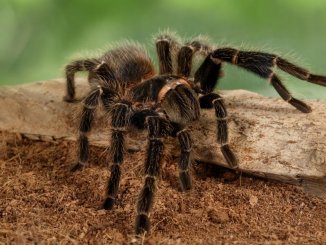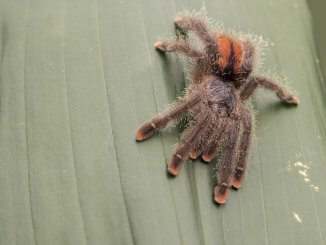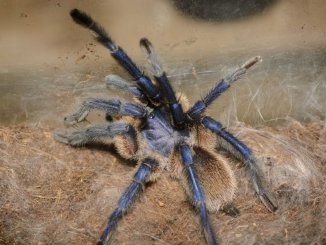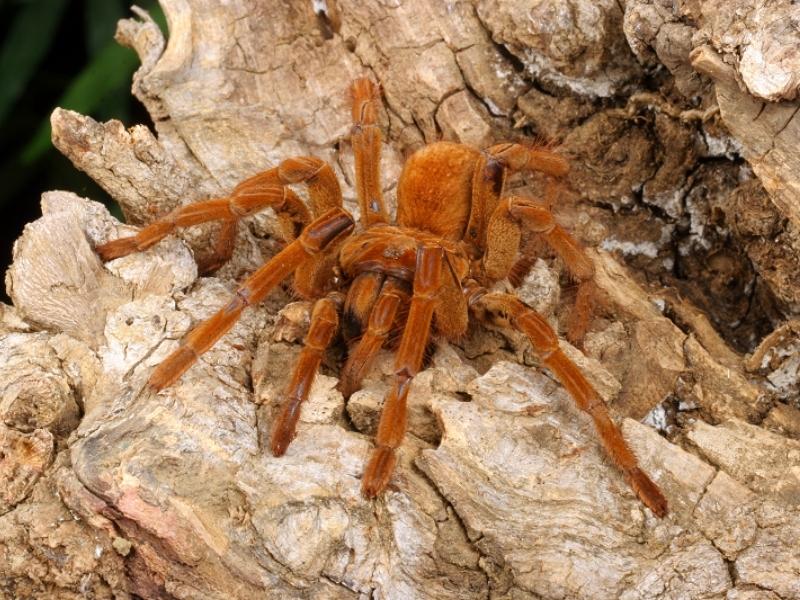
Native to northern South America, the goliath birdeater tarantula is the largest spider species in the world by mass and body length. The tarantula is thick, hairy, and comes in shades of brown.
Caring for the goliath birdeater spider is difficult because of its huge size and aggressive nature.
Goliath Birdeater Tarantula Overview
| Common name | Goliath birdeater, goliath bird eating tarantula, goliath birdeater spider |
| Scientific name | Theraphosa blondi |
| Natural habitat | Northern South America, Venezuela, French Guiana, Guyana, Suriname, Brazil |
| Adult size | Leg span up to 11 inches long, body length up to 5.1 inches |
| Average lifespan | Females up to 25 years, males up to 6 years |
| Diet | Carnivore |
| Housing | 30-gallon enclosure or larger, 75–82°F, 80% humidity |
| Experience | Advanced |
Origin
Goliath birdeaters (Theraphosa blondi) are native to northern South America, specifically the rainforest regions throughout Venezuela, French Guiana, Guyana, Suriname, and Brazil. These tarantulas favor humid, warm marshlands and pliable substrates.
The goliath bird eating tarantula is a terrestrial (ground-dwelling) species that spends most of its time in deep burrows. The spider hunts at night.
Goliath birdeaters are common in the wild but rare in captivity due to breeding difficulties. These spiders are venomous and bite when threatened or stressed, though the venom isn’t lethal to humans, with the pain comparable to a bee sting.
This spider is considered a delicacy in certain parts of northeastern South America. Roasted with banana leaves, the goliath birdeater tarantula has a shrimp-like flavor.
Appearance and Behavior
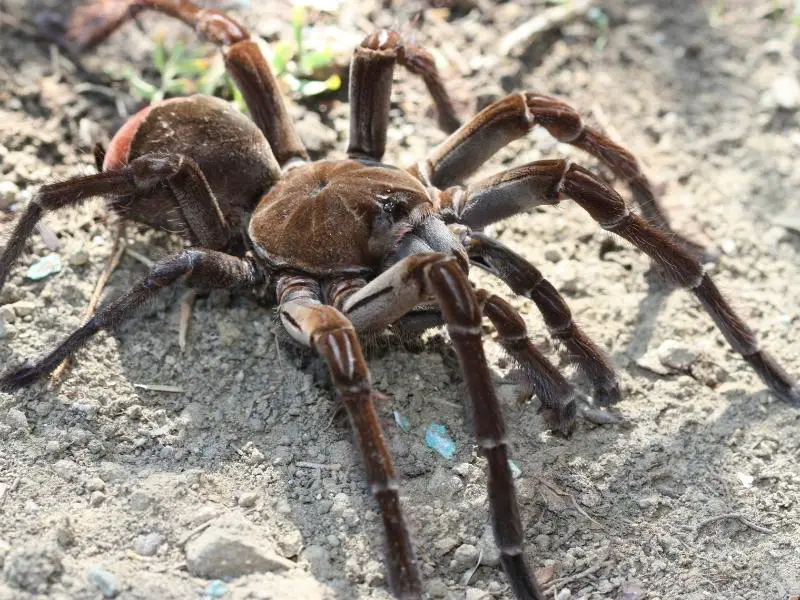
The goliath birdeater is a large spider species with a stocky body that comes in various shades of brown, gold, and tan. The tarantula is covered in urticating hairs — stinging, barbed bristles that help ward off predators — and has thick, broad appendages that allow it to dig through the firm substrate. The spider also has large, inch-long fangs.
Unlike most other tarantula species, goliath birdeater males lack mating hooks (tibial spurs). Males have longer legs and are slimmer than females.
Goliath birdeater tarantulas have two appendages on their mouth, known as chelicerae and pedipalps, that help them detect, catch, and subdue prey. The chelicerae contain venom while the pedipalps function as feelers. All spiders have eight legs.
Size and Lifespan
The goliath bird-eating spider is the largest tarantula species in the world, except in terms of leg span, in which the giant huntsman spider reigns with a leg span up to 12 inches. Goliath birdeaters can reach a weight of 175 grams, a body size of 5.1 inches, and a total leg span of 11 inches.
With proper care, females live for 15 to 25 years while males live for 3 to 6 years. A high enclosure temperature, power feeding, and unsanitary conditions can shorten a tarantula’s life expectancy.
Goliath birdeater spiderlings are fast growers and molt frequently. Expect these tarantulas to grow up to 4 inches per year until maturity.
Females are stockier and larger than males. However, the most reliable method for sexing a tarantula is to examine its molted exoskeleton. Females will have a prominent pouch, known as a spermatheca, just above the epigastric furrow.
Temperament
The goliath bird-eating spider is an aggressive, fast-moving species that will stand its ground no matter the threat. The tarantula usually defends itself with stridulation, where it makes a hissing sound by rubbing bristles on its legs together, though it also rears its body, flicks urticating hairs, and occasionally bites.
The goliath birdeater tarantula’s venom isn’t lethal to humans and typically only causes swelling and mild pain for several hours. However, the spider’s urticating hairs are a lot more painful and can cause rashes, blisters, and an itching or burning sensation for several days.
Goliath birdeater tarantulas are best kept singly. These tarantulas are territorial and often attack their own kind.
Housing Goliath Birdeater Tarantulas
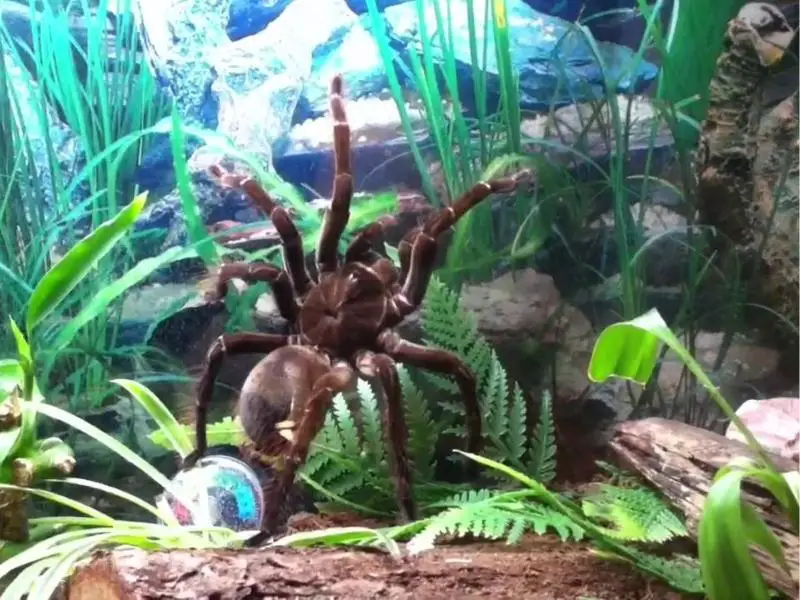
In the wild, the goliath birdeater tarantula lives in the tropical rainforests of northern South America. The spider particularly thrives in areas that are warm, moist, densely vegetated, and sheltered from harsh light.
Simulate these living conditions in the enclosure to help the goliath birdeater feel secure and at ease. House the tarantula in a wide, glass terrarium with a deep substrate.
Enclosure size
Goliath birdeater tarantulas require a 30-gallon terrarium or larger, with more width and length than vertical space. The enclosure should comfortably accommodate the spider’s full adult size, a 10-inch substrate layer, decorations, and a water bowl.
Lighting
Establish a photoperiod — a day to night cycle — to give goliath birdeaters a sense of time. Position the enclosure in the room so that it isn’t exposed to direct sunlight, but still gets dim lighting for 9 to 12 hours during the day.
Avoid using artificial UVB lighting or heat lamps because these aren’t necessary and can make the spider dehydrated, distressed, and sick.
Temperature and Humidity
The goliath birdeater does best in temperatures between 75 and 82°F. If the room temperature falls below 75°F, add a heating pad at one end of the enclosure to keep it within the appropriate temperature range.
A heating pad can also be used to create a thermal gradient, allowing the tarantula to warm or cool itself down as it pleases.
Goliath birdeater tarantulas prefer a high humidity level of around 80%. Add a large water dish, reduce ventilation, and mist the substrate daily to improve the humidity in the enclosure. The substrate should be damp to the touch but never soaking.
Use a digital hygrometer and thermometer to check the terrarium’s parameters daily. Although high humidity is preferred, ensure the enclosure still has good cross-ventilation to prevent the air from becoming stagnant.
Substrate and Decoration
Goliath birdeater tarantulas are deep burrowers that need a substrate layer of at least 10 inches. Opt for a substrate that’s pliable, soft, and easy to spot clean, like cypress mulch, peat moss, or potting soil without fertilizers. Avoid substrates that don’t retain moisture well or are prone to mold or fungus.
Add a sturdy, large water dish into the enclosure and use clay pots, cork bark, and artificial foliage to create shelter and hiding places.
Cleaning
Spot clean the goliath birdeater’s enclosure daily. Use tongs to carefully remove leftover food, dirty substrate, old molts, and waste. Rinse the water bowl completely if the spider has fouled inside it.
The goliath birdeater tarantula is highly defensive and territorial, so clean during the daytime — when the spider is resting in its burrow — and don’t make an excessive amount of noise to minimize disturbance. Wear gloves to protect your skin from trapped urticating hairs within the substrate.
Deep clean if there are foul odors or the enclosure has become infested with mold. Move the tarantula into a temporary terrarium, then remove the substrate and wash the decorations, dish, and vivarium walls with warm water. Don’t use cleaning chemicals that release harmful fumes.
Replace the substrate and add the decorations back into the enclosure once everything is dry. Also check the thermometer, heating pad, and hygrometer are in working order.
The goliath birdeater tarantula shouldn’t be handled during the cleaning process. Instead, use a secure container to transport the spider between enclosures.
Goliath Birdeater Tarantula Care
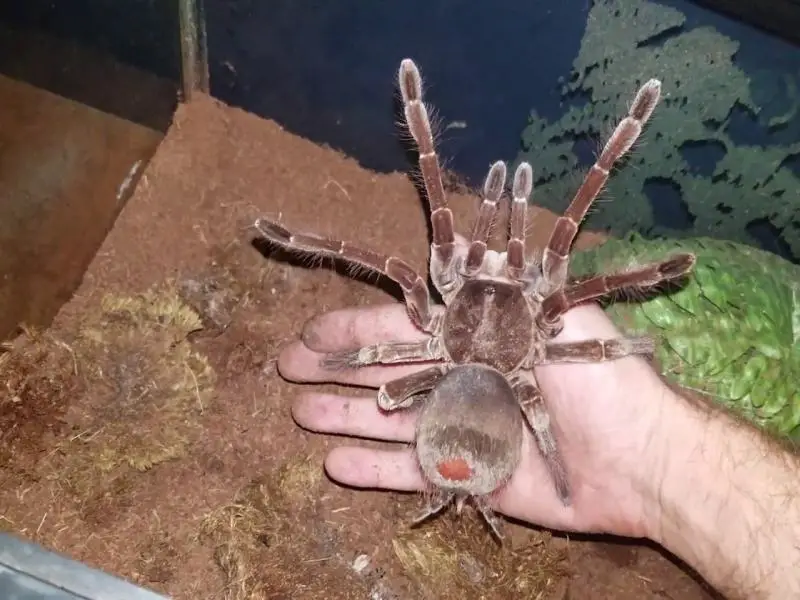
The goliath birdeater tarantula is challenging to care for. The spider is extremely large, aggressive, and prone to sickness in poor enclosure conditions.
Food and Water
In the wild, the goliath birdeater tarantula has a varied diet that primarily consists of invertebrates, small rodents, and insects, though it sometimes feeds on small birds and reptiles like lizards. The tarantula is most active at night and ambushes prey from its burrow.
Goliath birdeater tarantulas benefit from a varied, protein-rich diet in captivity. Provide gut-loaded live food items such as mealworms, dubia roaches, and crickets, with the occasional pinkie mouse as a treat.
Feed adult goliath birdeater tarantulas a few insects every 10 days. Young spiderlings require more regular feedings, around two to three meals per week, to support their development. Choose size-appropriate food such as small pinhead crickets and mealworms.
Add the food into the enclosure at night to mimic the tarantula’s nocturnal hunting behavior. Remove any leftover food in the morning. Untouched prey is typically a sign the tarantula is about to undergo a molt, though if this is paired with other symptoms, such as abnormal movements or a shrunken abdomen, it could indicate sickness.
Add fresh water to the goliath birdeater’s dish daily. Ensure the dish is sturdy, shallow, but large enough for the tarantula to easily drink from.
Handling
Although the goliath birdeater’s venom isn’t lethal to humans, the spider shouldn’t be handled because it’s aggressive, fast-moving, and can inflict severe pain with its urticating hairs. Handling also causes unnecessary stress and puts the spider at risk of fall injuries.
Common Health Issues
Goliath birdeater tarantulas live long lives with proper care and ideal enclosure conditions. However, common ailments that affect these spiders include dehydration, molting problems, mold or fungus outbreaks, and mites.
Dehydration
When the tarantula isn’t getting enough moisture, either due to low humidity, a dry substrate, or lack of food or water. Symptoms of dehydration include lethargy, a shriveled abdomen, and a hunched appearance.
Severely dehydrated tarantulas should be moved to a humid container with a moist paper towel and water dish until they regain their strength.
Prevent dehydration by keeping the enclosure at a moderate to high humidity. Spray the substrate frequently to keep it moist.
Molting Issues
Most molting problems occur when the enclosure isn’t humid enough. Tarantulas can get stuck in their molts, putting them at risk of injuries and a slow death.
Keep the humidity above 75%, spray the substrate each day, and top up the water bowl daily to prevent molting issues. You also shouldn’t leave live food in the enclosure while the goliath birdeater molts — the tarantula can’t defend itself and is extremely vulnerable to attacks until its exoskeleton hardens.
Most goliath birdeaters finish molting within three days. A tarantula loses its appetite, becomes lethargic, and lies on its back during the molting process. Spiderlings molt more often than adults.
Discard the old exoskeleton after the tarantula has finished molting to prevent the enclosure from becoming dirty.
Mold or Fungus Outbreak
A hot, humid environment, paired with poor sanitary conditions, can quickly cause mold or fungus to spread. An outbreak can infect the tarantula’s internal organs, causing life-threatening complications.
Symptoms include white patches on the spider, behavioral changes, discoloration, and lethargy. Prevent outbreaks by performing regular spot cleans and ensuring there’s adequate cross-ventilation.
Mites
Mites are often present in goliath birdeater tarantula enclosures and feed on decaying organic matter. While relatively harmless and even beneficial in small amounts, an abundant population can overrun the enclosure and cause significant distress.
Keep mite populations in check by cleaning up waste and leftovers regularly. Mites that have latched onto the tarantula can be removed with a cotton swab covered in petroleum jelly, though be extremely cautious.
Breeding
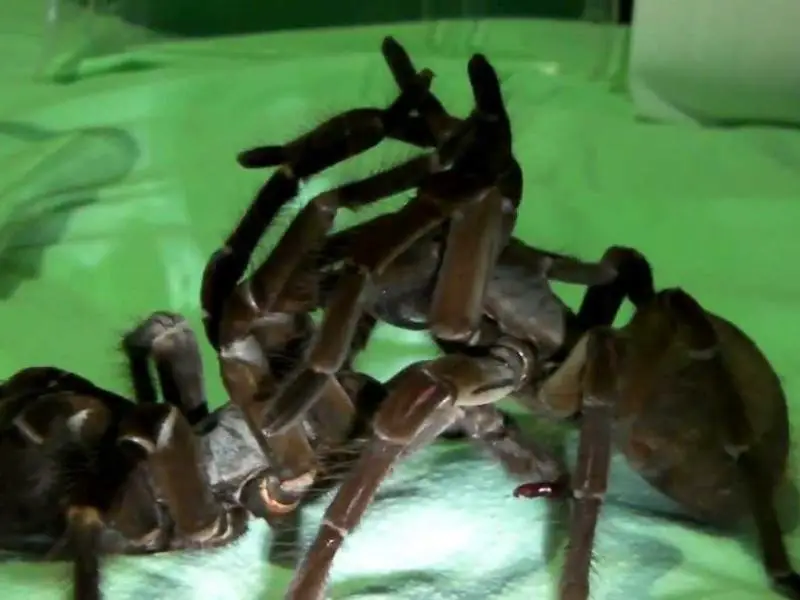
Goliath birdeater tarantulas are difficult to breed in captivity. Females are selective, territorial, and often treat males as prey. After mating, the female produces around 100 to 200 eggs that take up to eight weeks to hatch. Expect spiderlings to reach sexual maturity within three years.
Breeding can occur soon after the female has molted:
- Once the male has produced a sperm web, slowly introduce him to the female’s terrarium. The male will approach the female while drumming his legs against the substrate to show interest. A recipient female will venture out of her burrow, rear up, and allow the male to insert his pedipalps into her reproductive opening to transfer the sperm
- Remove the male after the pair have finished to prevent the female from attacking him. Use a thin sheet to separate the pair, then, with a secure container, transfer the male back to his original enclosure
- Increase the female’s feeding frequency. If the mating was successful, the female will lay eggs and produce an egg sac within two months
Choosing and Buying a Goliath Birdeater Tarantula
Goliath birdeater tarantulas typically cost between $20 and $250. Females are more expensive than males because of the difference in life expectancy. Unsexed spiderlings are a lot more affordable than adults, with a price range of $10 to $50. Expect to pay more if you buy a large adult goliath birdeater tarantula from a reputable breeder.
Goliath birdeater tarantulas are rare and hard to find in pet stores. However, there are specialist breeders throughout the United States and spiderlings are often sold at expos.
Captive-bred goliath tarantulas are less likely to have health issues than wild-caught spiders. Signs of sickness include lethargy, parasites, a shrunken, shriveled appearance, and sores.

